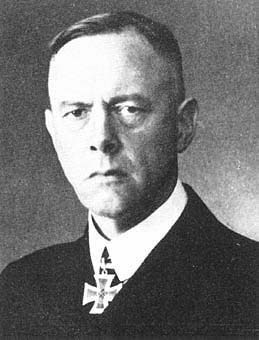How the Royal Navy Avenged the Hood
The War Illustrated, Volume 4, No. 93, Page 581, June 13, 1941.
Continued from the previous page.
A second hit was obtained by a torpedo on the starboard quarter of the German battleship. It was subsequently reported that on being hit during this attack the Bismarck made two complete circles and that her speed was again reduced. During the evening some of our destroyers of the Tribal class (1,870 tons), under the command of Capt. P. L. Vian, D.S.O., R.N., in H.M.S. Cossack, made contact soon after 11 p.m. Between 1.20 a.m. and 1.50 a.m. on Tuesday the Bismarck was attacked with torpedoes by H.M. destroyers Zulu, Cmdr. H. R. Graham, D.S.O., R.N.; Maori, Cmdr. H. T. Armstrong, D.S.O., R.N.; and Cossack. Cossack and Maori each hit with one torpedo. After Maori's attack it was reported that there was a fire on the forecastle of the German battleship.
One hour after these attacks by our destroyers it was reported that the Bismarck appeared to be stopped. She was then about 400 miles due west of Brest and had been pursued by our forces for more than 1,750 miles. It was subsequently reported that the Bismarck was again under way and had made good about eight miles in one hour, and that she was still capable of heavy and accurate gunfire. At daylight another striking force of naval aircraft was dispatched from Ark Royal, but this attack had to be cancelled owing to low visibility. Shortly after daylight Bismarck engaged our destroyers by gunfire. H.M. cruiser Norfolk was in action with the Bismarck almost immediately afterwards, and very soon the Bismarck was being engaged by our heavy ships. Details of this phase of the action have not yet been received. It is known, however, that H.M. cruiser Dorsetshire (9,975 tons), Capt. B. C. S. Martin, R.N., was ordered to sink the Bismarck with torpedoes. Bismarck sank at 11.01 this morning.
So reads the Admiralty communiqué of May 27; a second issued on May 29 adds;
The torpedo attacks by naval aircraft and the destroyer attack during Monday-Tuesday night, in which H.M. Destroyer Sikh) Commander G. H. Stokes, R.N.) took part, in addition to the ships already announced, resulted in the speed of the Bismarck being greatly reduced and her steering gear being put out of action. Both her main and secondary armament, however, remained effective. The C.-in-C. Home Fleet, intended to close the Bismarck at dawn and sink her by gunfire from H.M.S. King George V and H.M.S. Rodney. This intention, however, was abandoned owing to uncertain and variable visibility, which made it necessary to await full daylight before closing the enemy.
Shortly before 9 a.m. H.M.S. King George V and H.M.S. Rodney engaged the enemy with their main armament. The gunfire of these two battleships silenced the enemy. The C.-in-C. then ordered H.M.S. Dorsetshire to sink the Bismarck with torpedoes. As already announced, the Bismarck sank at 11.1 a.m., on May 27. More than 100 officers and men from the Bismarck were picked up by our forces and are prisoners of war.
Previous and next article from The Bismarck and The Hood
For 1750 Miles They Chased the Bismarck
"I have just received news that the Bismarck is sunk." In these words Mr. Churchill announced to an expectant House of Commons on May 27 the end of the chase of Hitler's newest and most powerful battl
I Was There! - How Our Catalina Shadowed the Bismarck
American-built Catalina flying-boats of the R.A.F. Coastal Command played a vital part in the tracking down of the ill-fated Bismarck. On occasion they encountered heavy fire from the battleship, as t
Index
Previous article
For 1750 Miles They Chased the Bismarck
"I have just received news that the Bismarck is sunk." In these words Mr. Churchill announced to an expectant House of Commons on May 27 the end of the chase of Hitler's newest and most powerful battl
Next article
I Was There! - Mine Were the Last R.A.F. Men to Leave
In addition to the Empire Forces, R.A.F. personnel had to be moved out of Greece when the position became untenable. The story of the escape of the last 2,000 was told by a senior staff officer who wa




